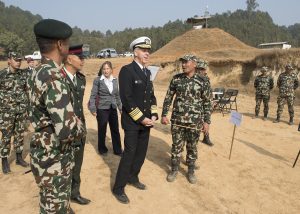[ad_1]

A Nepali Army soldier briefs Commander of the U.S. Indo-Pacific Command Adm. Phil Davidson on explosive ordnance exercises at the Birenda Peace Operations Training Center, January 11, 2019
Credit: Flickr/U.S. Indo-Pacific Command
One of the oldest armies in South Asia, the Nepal Army, founded in 1744, is undergoing a transformation as China and India beef up their military presence in areas bordering Nepal.
Amid escalating conflict between India and China and despite some signs of thaw, the risk of future confrontations between the two might have prompted the Nepal army to make the change. But according to the Army Spokesperson Santosh Ballabh Poudel, the plan was envisioned 15 years ago.
The army boasts of 95,000 personnel. The number increased after the civil war and there are concerns that the rising tensions between India and China might lead to a further increase in numbers.
The Nepal army has chucked its exiting organization of eight divisions and has created four geographical commands, with one strategic command in Kathmandu valley. The Nepal government has already approved the plan and the military will now have four command buildings under the army headquarters.
Four army generals have already been appointed for the new four commands.
The Nepal army had adopted a federal structure, with divisions corresponding to provinces, in consonance with the Nepal’s federal form of government. However, this model was rife with logistical problems and was deemed impractical.
While the Nepal army moves ahead with the restructuring, critics question the need to devote considerable resources to the military amid other spending priorities.
The army’s decision also comes at a time when both Indian and Chinese military forces are going through a rapid transformation.
It’s been almost a year since India and China engaged in their deadliest confrontation since the 1962 border war in eastern Ladakh. India’s disputes with Nepal around the Limpiyadhura, Kalapani and Lipulek areas are also going to haunt both nations for a long time.
The restructuring of the Nepal army will also include the the introduction of corps for logistics, medical services, signals, engineering, intelligence and others.
The Nepal army has already constructed a few air and logistics bases, and is planning to construct more for rescue, defense, and any other emergency purposes. The western airbase in Surkhet will cover the far west, and another base in Kathmandu is overlooking the valley and eastern region. Another under-construction airbase in Biratnagar will equip the eastern command. Two logistic bases have been built in Chitwan (east) and Banke (west), while another is being built in Bardibas (east). Three army hospitals already exist, in Pokhara, Itahari, and Nepalgunj.
The Nepal army last year opened a 250-meter track in Drachula, near Kalapani.
With a long experience in fighting wars, the Nepal army is on the path of embracing new strategies for any future potential Himalayan conflict. The arms competition between India and China will also force Nepal’s army to purchase military drones and other equipment for defense purposes, from China, India and other nations. China is already the world’s second-biggest arms manufacturer.
Although India had inherited links with the Nepal army via the British, United States, China, and even the U.K. will make it difficult for India to impose its will on Nepal’s military. Nepal army has existing ties with the British forces, has engaged in military drills with the United States, and has deepened ties with China’s People Liberation Army. It will continue to bolster these ties as well as it capabilities to protect its sovereignty.
[ad_2]
Source link